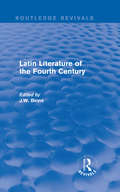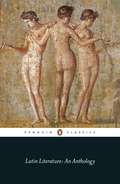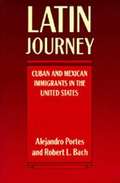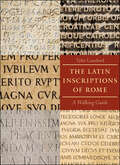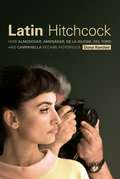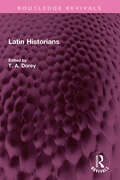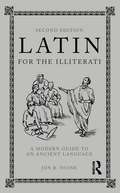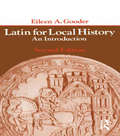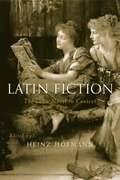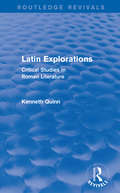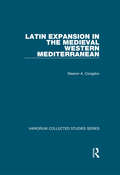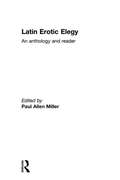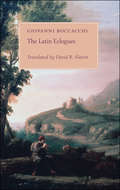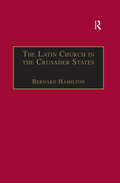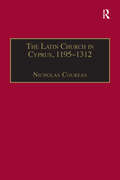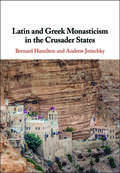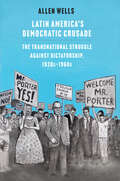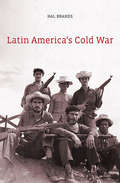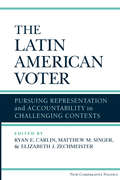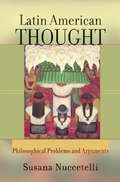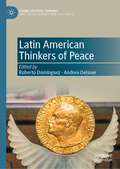- Table View
- List View
Latin Literature of the Fourth Century (Routledge Revivals)
by J. W. BinnsThis volume, offering an insight into the literary world of Rome in the fourth century AD, reflects an increased interest in the writers of the 150 years before the collapse of the Western Empire, who have long been over-shadowed by the pre-eminence accorded since the eighteenth century to the Golden and Silver ages. Among the writers examined are Ausonius, the poet, Imperial official and tutor to Gratian; Claudian, the last major ‘classical’ poet; Prudentius, and Paulinus of Nola, two of the founders of Christian Latin poetry; Symmachus, the letter writer and supporter of die-hard paganism; and St. Augustine, whose influence on Christian thought and the Middle Ages is incalculable. These essays consider how such writers responded to a world where vitality was ebbing from the old forms of political life, religion and literature, giving way to new institutions, modes of life and horizons of reflection.
Latin Literature: An Anthology
by Michael GrantA classic introduction to Latin literature, with translations of the best passages from Virgil, Livy, Ovid, Seneca and many others.This classic anthology traces the development of Latin literature from the early Republican works of Cicero and Catullus, to the writers of the Empire such as Lucan and Petronius, to the later writings of St Augustine. The selections cover comedy and epic, history and philosophy, in prose and in verse, and each passage is prefaced by an introduction to the author and his influence. The translators range across history from Alexander Pope and Lord Byron to contemporaries. The result is a broad and brilliant overview of the civilization of Rome and its Empire - an ideal introduction to Latin literature.Michael Grant was born in 1914. He served as an intelligence officer during the Second World War, and subsequently held academic posts at the universities of Cambridge, Edinburgh, Khartoum and Belfast. Over his lifetime, he published nearly fifty books on the ancient world, ranging from studies of Roman coinage, to biographies of Caesar, Nero and Jesus, to books on Ancient Israel and the Middle Ages. Many of his translations were published in Penguin Classics. Professor Grant moved to Italy in 1966, where he spent most of the rest of his life until his death in 2004.
Latin Journey: Cuban and Mexican Immigrants in the United States
by Alejandro Portes Robert L. BachLatin Journey details an eight-year study of Mexican and Cuban immigrants to the U.S.
The Latin Inscriptions of Rome: A Walking Guide
by Tyler LansfordRome’s oldest known Latin inscription dates from the sixth century BC; the most recent major specimen was mounted in 2006—a span of more than two and a half millennia. Remarkably, many of these inscriptions are still to be found in situ, on the walls, gates, temples, obelisks, bridges, fountains, and churches of the city. Classicist Tyler Lansford has collected some 400 of these inscriptions and arranged them—with English translations—into fifteen walking tours that trace the physical and historical contours of the city. Each itinerary is prefaced by an in-depth introduction that provides a survey of the history and topography of the relevant area of the city. The Latin texts appear on the left-hand page with English translations on the right. The original texts are equipped with full linguistic annotation, and the translations are supplemented with historical and cultural notes that explain who mounted them and why.This unique guide will prove a fascinating and illuminating companion for both sophisticated visitors to the Eternal City and armchair travelers seeking a novel perspective into Rome's rich history.
The Latin Inscriptions of Rome: A Walking Guide
by Tyler LansfordA collection of 15 guided walking tours of the ancient Latin descriptions found throughout Rome. Rome&’s oldest known Latin inscription dates from the sixth century BC; the most recent major specimen was mounted in 2006—a span of more than two and a half millennia. Remarkably, many of these inscriptions are still to be found in situ, on the walls, gates, temples, obelisks, bridges, fountains, and churches of the city. Classicist Tyler Lansford has collected some 400 of these inscriptions and arranged them—with English translations—into fifteen walking tours that trace the physical and historical contours of the city. Each itinerary is prefaced by an in-depth introduction that provides a survey of the history and topography of the relevant area of the city. The Latin texts appear on the left-hand page with English translations on the right. The original texts are equipped with full linguistic annotation, and the translations are supplemented with historical and cultural notes that explain who mounted them and why. This unique guide will prove a fascinating and illuminating companion for both sophisticated visitors to the Eternal City and armchair travelers seeking a novel perspective into Rome's rich history.&“This book is wonderful. . . . Lansford&’s evocative depictions of monuments, cityscape, and memorable humans have inspired me anew with the fascination of Rome.&” —Mary T. Boatwright, Duke University&“If this book is not slipped into many a Rome-bound suitcase, there is no justice in the world. I can think of few more enjoyable companions on a prowl through the city.&” —Jane Stevenson, Times Literary Supplement (UK)
Latin Hitchcock: How Almodóvar, Amenábar, De la Iglesia, Del Toro and Campanella Became Notorious
by Dona KercherThis study explores how five major Spanish and Latino directors modeled their early careers on Hitchcock and his film aesthetics.
Latin Hitchcock: How Almodóvar, Amenábar, De la Iglesia, Del Toro, and Campanella Became Notorious
by Dona KercherThis study explores how five major directors—Pedro Almodóvar, Alejandro Amenábar, Alex de la Iglesia, Guillermo del Toro, and Juan José Campanella—modeled their early careers on Hitchcock and his film aesthetics. In shadowing Hitchcock, their works embraced the global aspirations his movies epitomize. Each section of the book begins with an extensive study, based on newspaper accounts, of the original reception of Hitchcock's movies in either Spain or Latin America and how local preferences for genre, glamour, moral issues, and humor affected their success. The text brings a new approach to world film history, showcasing both the commercial and artistic importance of Hitchcock in Spain and Latin America
Latin Historians (Routledge Revivals)
by T. A. DoreyFirst published in 1966, Latin Historians gives an account of some of the most important Latin historians. There are chapters on Caesar, Sallust, Livy and Ammianus Marcellinus, together with an account of earlier historians, and on Polybius, the Greek who had much influence on the Roman World. Bede, the earliest of the great Christian historians in England, is also discussed. This book will be of interest to students of history, literature and classical studies.
Latin for the Illiterati: A Modern Guide to an Ancient Language
by Jon R. StoneThis revised and updated edition includes a brand new foreword by Richard LaFleur and more than fifteen hundred new entries and abbreviations. Organized alphabetically within the categories of verba (common words and expressions), dicta (common phrases and familiar sayings), and abbreviations, this practical and helpful reference guide is a comprehensive compendium of more than 7,000 Latin words, expressions, phrases, and sayings taken from the world of art, music, law, philosophy, theology, medicine and the theatre, as well as witty remarks and sage advice from ancient writers such as Virgil, Ovid, Cicero, and more.
Latin for Local History: An Introduction
by Eileen A. GooderLatin for Local History provides a self-teaching guide for those historians who wish to tackle the language in which the majority of pre-eighteenth century historical records have been written. It is unique in dealing only with Latin found in historical records of the medieval period. Practice material and exercises are provided in the form of documents most commonly encountered by the historian in their research - deeds, charters, court rolls, accounts, bishops' registers and so on.
Latin Fiction: The Latin Novel In Context
by Heinz HofmannLatin Fiction provides a chronological study of the Roman novel from the Classical period to the Middle Ages, exploring the development of the novel and the continuity of Latin culture. Essays by eminent and international contributors discuss texts including: * Petronius, Satyrica and Cena Trimalchionis* Apuleius, Metamorphose(The Golden Ass) and The Tale of Cupid and Psyche* The History of Apollonius of Tyre* The Trojan tales of Dares Phrygius and Dictys Cretensis* The Latin Alexander* Hagiographic fiction* Medieval interpretations of Cupid and Pysche, Apollonius of Tyre and the Alexander Romance. For any student or scholar of Latin fiction, or literary history, this will definitely be a book to add to your reading list.
Latin Explorations: Critical Studies in Roman Literature (Routledge Revivals)
by Kenneth QuinnLatin Explorations, first published in 1963, offers a fresh approach to Roman poetry from Catullus to Ovid. Traditionally, the period is divided for specialist studies – Lyric, Epic and Elegy. In each of them, techniques of interpretation prevail, isolated from contemporary ideas about poetry and dominated by barriers between ‘textual’, ‘exegetical’ and ‘aesthetic’ criticism. Kenneth Quinn discerns in Roman poetry of this period the adolescence, maturity and decay of a single coherent tradition whose internal unity surpasses differences of form. His argument attempts to reverse the dissociation of purely academic research from appreciative criticism, whilst also incorporating the work of textual scholars. Each chapter is supported by a detailed analysis of the texts: nearly 700 lines of poetry are discussed and translated. Latin Explorations will be of significant value not only to students of the Classics, but also to the ‘Latinless’ general reader who is interested in Roman literature.
Latin Expansion in the Medieval Western Mediterranean (The Expansion of Latin Europe, 1000-1500)
by Eleanor A. CongdonWhile Latin expansion stalled in the Eastern Mediterranean in the late Middle Ages, Islam lost ground to Christendom in the west - in the Spanish Levant, the islands of the Western Mediterranean, and even on the Maghribi coast, where conquerors and colonists from the northern shore of the sea established footholds. Edited by Eleanor Congdon, with an introduction by Felipe Fernández-Armesto and James Muldoon, this collection of classic studies illuminates the problems of how the expansion occurred and why it was slow and limited. The volume broaches fundamental questions of Mediterranean history formulated by Henri Pirenne and Fernand Braudel. The place of the late medieval Western Mediterranean in the history of the sea as a whole and of European overseas expansion generally emerges with new clarity, as the reader re-traces the process of formation of one of the world’s great frontiers between civilizations. Important work by Maria Teresa Ferrer i Mallol appears in translation for the first time, alongside pieces by such leading authorities as David Abulafia, Robert I. Burns, S.J., Miguel Angel Ladero Quesada, and Hilmar C. Krueger.
Latin Erotic Elegy: An Anthology and Reader
by Paul Allen MillerThis indispensable volume provides a complete course on Latin erotic elegy, allowing students to trace a coherent narrative of the genre's rise and fall, and to understand its relationship to the changes that marked the collapse of the Roman republic, and the founding of the empire.The book begins with a detailed and wide-ranging introduction, looking at major figures, the evolution of the form, and the Roman context, with particular focus on the changing relations between the sexes. The texts that follow range from the earliest manifestations of erotic elegy, in Catullus, through Tibullus, Sulpicia (Rome's only female elegist), Propertius and Ovid.An accessible commentary explores the historical background, issues of language and style, and the relation of each piece to its author's larger body of work. The volume closes with an anthology of critical essays representative of the main trends in scholarship; these both illuminate the genre's most salient features and help the student understand its modern reception.
The Latin Eclogues
by Giovanni BoccaccioGiovanni Boccaccio is famous for his masterpiece The Decameron, but his Latin Eclogues are relatively unknown. David R. Slavitt’s English translation makes these important pieces accessible to a new audience of readers. Elegant and engaging, these pastoral poems address the great issues of Boccaccio’s Italy, including the political and military intrigues of the day. Boccaccio modeled his poems on Petrarch’s eclogues and, before him, those of Virgil and Theocritus. Slavitt’s impeccable translations are highly readable, while his editorial interjections both elucidate the poet’s intended meaning and frame the poems for the reader. These charming works offer wonderful insight into daily life in Renaissance Italy. A prolific and award-winning translator, Slavitt turns the Eclogues into vibrant modern English, capturing not only the words of Boccaccio but the flavor of the original language.The availability of The Latin Eclogues in English is a major contribution to the study of the literature and history of the Italian Renaissance.
The Latin Church in the Crusader States: The Secular Church
by Bernard HamiltonThis is the first major work on the history of the secular church in the Frankish states of Syria and the Holy Land - a subject which has not hitherto attracted the interest of ecclesiastical historians. The present book has been written to fill this important gap in crusader studies. It deals with the period stretching from the establishment of a Latin hierarchy after the First Crusade to the final conquest by the Mamluks in 1291. Dr Hamilton examines the development of the Church in the Patriarchates of Jerusalem and Antioch and its organisation from the parish level upwards. Two chapters are devoted to a study of its sources of income and the financial problems that arose after the Battle of Hattin through the thirteenth century. Particular attention is paid to the relations between the Latin and the Eastern Churches. The author documents the unequal treatment given to the Orthodox and to the separated Churches, and traces the course of the various attempts at church union. In his conclusion he makes an overall assessment of the spiritual achievments of the Church during this period and the extent to which it justified the first crusaders' ideals.
The Latin Church in Norman Italy
by G. A. LoudFirst published in 2007, this was the first significant study of the incorporation of the Church in southern Italy into the mainstream of Latin Christianity during the eleventh and twelfth centuries. Professor G. A. Loud examines the relationship between Norman rulers, south Italian churchmen and the external influence of the new 'papal monarchy'. He discusses the impact of the creation of the new kingdom of Sicily in 1130; the tensions that arose from the papal schism of that era; and the religious policy and patronage of the new monarchs. He also explores the internal structures of the Church, both secular and monastic, and the extent and process of Latinisation within the Graecophone areas of the mainland and on the island of Sicily, where at the time of the Norman conquest the majority of the population was Muslim. This is a major contribution to the political, religious and cultural history of the Central Middle Ages.
The Latin Church in Cyprus, 1195–1312
by Nicholas CoureasThis is a study of the first century of the Latin Church on Cyprus, following the island’s loss to the Byzantine empire and its conquest by Richard the Lionheart in 1195. It covers both secular and regular clergy, and deals with the complex relations between church and crown, the nobility, and the urban Latin population within the island, as well as its relations with the papacy and the other Latin churches of the East. Not least, it analyses the troubled relations between the Latin and the Orthodox churches. An important feature of the book is the new light thrown on the links between the Church of Cyprus and the Latin patriarchs of Jerusalem and Antioch, and on the expansion of the Latin Church in the East, in the Byzantine territories conquered following the Fourth Crusade. This book is the first in-depth account of the religious history of the Latin kingdom of Cyprus which was the most durable of all the latin states established by the Crusaders in the Eastern Mediterranean.
Latin Biography (Routledge Revivals)
by T. A. DoreyFirst published in 1967, Latin Biography contains chapters on Nepos, Plutarch and Suetonius, the three best-known Classical biographers. There are also accounts of the less-familiar works of Q. Curtius Rufus and the author – or authors – of the Historia Augusta, and three chapters deal with the development of Latin biography in the Middle Ages. The Middle Ages were indebted to Suetonius, Shakespeare to Plutarch, Gibbon to the Historia Augusta. Since the Renaissance their methods have gradually been superseded by a more critical and scientific approach, but the ancient biographers can always claim the credit for having established biography as a major form of literature. This book will be of interest to students of literature and classical studies.
Latin and Greek Monasticism in the Crusader States
by Bernard Hamilton Andrew JotischkyMonasticism was the dominant form of religious life both in the medieval West and in the Byzantine world. Latin and Greek Monasticism in the Crusader States explores the parallel histories of monasticism in western and Byzantine traditions in the Near East in the period c.1050-1300. Bernard Hamilton and Andrew Jotischky follow the parallel histories of new Latin foundations alongside the survival and revival of Greek Orthodox monastic life under Crusader rule. Examining the involvement of monasteries in the newly founded Crusader States, the institutional organization of monasteries, the role of monastic life in shaping expressions of piety, and the literary and cultural products of monasteries, this meticulously researched survey will facilitate a new understanding of indigenous religious institutions and culture in the Crusader states.
Latin America's Democratic Crusade: The Transnational Struggle against Dictatorship, 1920s-1960s
by Allen WellsBy emphasizing Latin American reformers’ decades-long struggle to defeat authoritarianism, this transnational history challenges the timeworn Cold War paradigm and recasts the region’s political evolution Scholars persist in framing the Cold War as a battle between left and right, one in which the Global South is cast as either witting or unwitting proxies of Washington and Moscow. What if the era is told from the perspective of the many who preferred reform to revolution? Scholars have routinely neglected, dismissed, or caricatured moderate politicians. In this book, Allen Wells argues that until the Cuban Revolution, the struggle was not between capitalism and communism—that was Washington’s abiding preoccupation—but between democracy and dictatorship. Beginning in the 1920s, the fight against authoritarianism was contested on multiple fronts—political, ideological, and cultural—taking on the dimensions of a political crusade. Convinced that despots represented an existential threat, reformers declared that no civilian government was safe until the cancer of dictatorship was excised from the hemisphere. Dictators retaliated, often with deadly results, exporting strategies that had been honed at home to guarantee their political survival. Grafted onto this war without borders was a belated Cold War, with all its political convulsions, the aftershocks of which are still felt today.
Latin America’s Cold War
by Hal BrandsFor Latin America, the Cold War was anything but cold. Nor was it the so-called “long peace” afforded the world’s superpowers by their nuclear standoff. In this book, the first to take an international perspective on the postwar decades in the region, Hal Brands sets out to explain what exactly happened in Latin America during the Cold War, and why it was so traumatic. Tracing the tumultuous course of regional affairs from the late 1940s through the early 1990s, Latin America’s Cold War delves into the myriad crises and turning points of the period—the Cuban revolution and its aftermath; the recurring cycles of insurgency and counter-insurgency; the emergence of currents like the National Security Doctrine, liberation theology, and dependency theory; the rise and demise of a hemispheric diplomatic challenge to U.S. hegemony in the 1970s; the conflagration that engulfed Central America from the Nicaraguan revolution onward; and the democratic and economic reforms of the 1980s. Most important, the book chronicles these events in a way that is both multinational and multilayered, weaving the experiences of a diverse cast of characters into an understanding of how global, regional, and local influences interacted to shape Cold War crises in Latin America. Ultimately, Brands exposes Latin America’s Cold War as not a single conflict, but rather a series of overlapping political, social, geostrategic, and ideological struggles whose repercussions can be felt to this day.
The Latin American Voter: Pursuing Representation And Accountability In Challenging Contexts
by Ryan E. Carlin Matthew M. Singer Elizabeth J. ZechmeisterIn this volume, experts on Latin American public opinion and political behavior employ region-wide public opinion studies, elite surveys, experiments, and advanced statistical methods to reach several key conclusions about voting behavior in the region's emerging democracies. In Latin America, to varying degrees the average voter grounds his or her decision in factors identified in classic models of voter choice. Individuals are motivated to go to the polls and select elected officials on the basis of class, religion, gender, ethnicity and other demographic factors; substantive political connections including partisanship, left-right stances, and policy preferences; and politician performance in areas like the economy, corruption, and crime. Yet evidence from Latin America shows that the determinants of voter choice cannot be properly understood without reference to context--the substance (specific cleavages, campaigns, performance) and the structure (fragmentation and polarization) that characterize the political environment. Voting behavior reflects the relative youth and fluidity of the region's party systems, as parties emerge and splinter to a far greater degree than in long-standing party systems. Consequently, explanations of voter choice centered around country differences stand on equal footing to explanations focused on individual-level factors.
Latin American Thought: Philosophical Problems and Arguments
by Susana NuccetelliMany of the philosophical questions raised in Latin America may seem to be among the perennial problems that have concerned philosophers at different times and in different places throughout the Western tradition, but they are not altogether the same--for Latin American thinkers have often adapted them to capture problems presented by new circumstances, and sought resolutions with arguments that are indeed novel. This book explains how well-established philosophical traditions gave rise in the New World to a characteristic form of thought not to be found in other cultures. There was no clean sweep of the past and an attempt to start over: rather, Latin American thinkers gradually adapted European ideas to their needs, sometimes borrowing on a larger scale, sometimes less. It is then no surprise that, under Iberian rule, Scholasticism became the accepted view and began to lose its grip only when the rulers did. But what does seem surprising is the radical way in which those traditions were on occasions challenged, as illustrated by the cases of José de Acosta, a Jesuit priest in Peru, and the Mexican nun, Juana Inés de la Cruz-each of whom spoke out against certain aspects of the official philosophy in colonial society. And when theories familiar elsewhere arrived to Latin America, as in the cases of positivism and Marxism, they were often seen differently in the light of new circumstances. But above all, this book shows that there is a body of interesting philosophical arguments offered by Latin Americans concerning problems that have arisen in Spanish- and Portuguese-speaking parts of the New World. In connection with this purpose, it examines how Latin Americans have thought about philosophical issues belonging to metaphysics, philosophy of science, cross-cultural psychology, feminist epistemology, ethics, and social and political philosophy. These are taken up in due course, paying special attention to questions of rationality, gender discrimination, justice, human rights, reparation for historically dispossessed native peoples, and relativism vs. universalism--all matters of continuing concern in Latin American thought, from its earliest stirrings to the present day. And among some specific issues that have generated heated controversies from the early twentieth century to the present, the book explores how Latin Americans and their descendants abroad think of their own cultural identity, examines their critique of US mass-culture and moral philosophy, and considers at some length the vexing problem of which name, if any, is the correct one to use to refer to all of this exceedingly diverse ethnic group. A closer look at the defining elements of Latin American identity has often led to questions concerning the characteristic features that might distinguish Latin Americans and their descendants abroad from other peoples of the world, the existence of a typically Latin American philosophy, and the correct name to refer to them. These, often conflated in the literature, are treated separately by the author, who favors a historically-based account of Latin-American identity. She also argues that the existence of a characteristically Latin American philosophy can be shown-though not by appealing to some standard but implausible reasons. And to resolve the question concerning a correct ethnic-group name, she proposes a new approach to the semantics of those names.
Latin American Thinkers of Peace (Global Political Thinkers)
by Roberto Domínguez Andrea OelsnerThis book analyzes seven Latin American thinkers who have contributed to building bridges for reconciliation and peace: Carlos Saavedra Lamas, Adolfo Pérez Esquivel, Alfonso García Robles, Óscar Arias Sánchez, Rigoberta Menchú Tum, Juan Manuel Santos, and Javier Pérez de Cuéllar. Working within an eclectic conceptual approach to systematize the circulation of ideas embraced by each one of the thinkers, the various contributions delve into the current literature of leadership and intellectuals in Politics and Global International Relations (GIR). Overall, the central premises of the analysis are based on three fundamentals of mainstream constructivism: a) change across time and space in the lifetime of each thinker under analysis in this book; b) socialization through changing norms, rules, and language; and c) processes of interaction in which actors make choices in selecting networks and strategies). Coming from different walks of life, the seven thinkers examined in this book have accessed the global public square and discussed ideas to reduce conflicts at different scales. In their respective historical times, they circulated their views and ideas beyond the confines of Latin America to influence global political thought and produce change in favor of peace.
